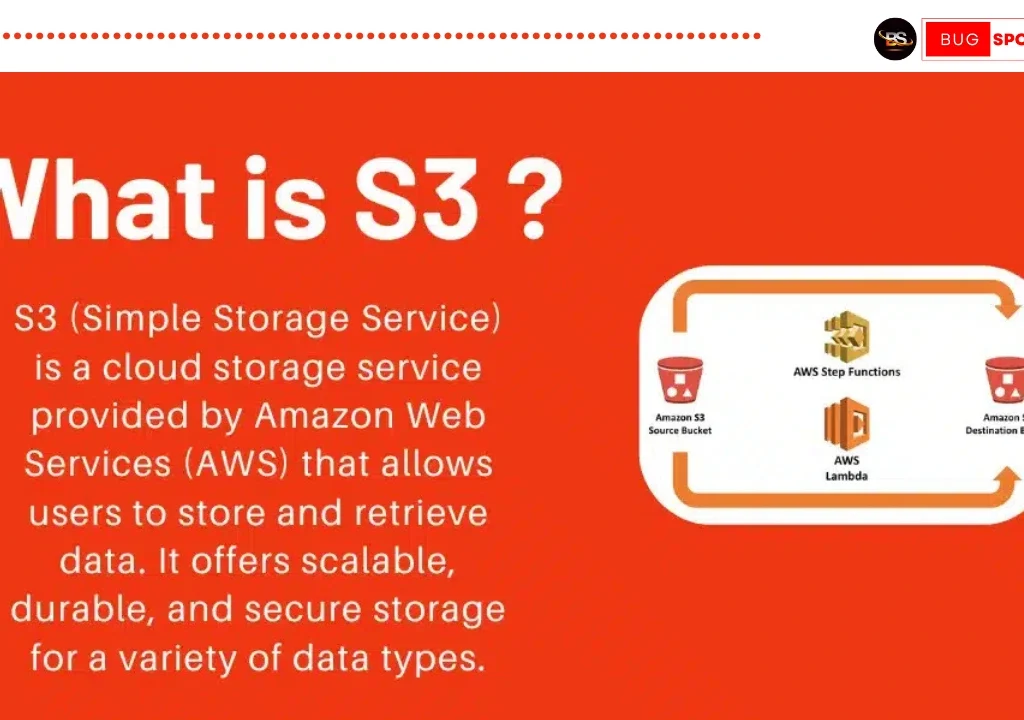What is S3 ?

What is S3 ?
Amazon S3 (Simple Storage Service) is a cloud-based object storage service provided by Amazon Web Services (AWS). It’s designed to store and retrieve large amounts of data at any time, from anywhere in the world. S3 is ideal for a wide variety of use cases, including storing documents, images, videos, backups, data lakes, and more. With S3, users can scale their storage needs easily as their data grows, with the assurance that their files are secure, highly available, and durable.
S3 Key Features
Scalable Storage:
- This service allows users to expand their storage capacity seamlessly. As your data grows, the service automatically scales to meet your needs, without any upfront investment or complexity.
- It’s ideal for businesses of all sizes, from startups with minimal storage needs to large enterprises handling petabytes of data.
High Availability and Durability:
- Amazon’s cloud storage solution offers 99.999999999% durability over the course of a year, ensuring your data is safe, secure, and consistently available.
- Data is stored across multiple servers and data centers, providing redundancy. In case one location experiences issues, others continue to serve the data, guaranteeing access when you need it most.
Security:
- Protecting data is a priority. Built-in encryption options ensure that stored data is securely protected. The service also provides access control features, such as IAM (Identity and Access Management) policies, that help define who can access specific data or perform certain actions.
- For extra protection, data can be encrypted both during transfer and while stored at rest.
Flexible Storage Classes:
- Different types of data have different needs. Whether it’s frequently accessed content or long-term archival data, there are various storage classes available to optimize cost-efficiency.
- For instance, the Standard class is for active data, while Glacier offers lower-cost archival storage for rarely accessed files.
- These storage options enable businesses to manage their data with varying access needs, ensuring they pay only for what they use.
- Different types of data have different needs. Whether it’s frequently accessed content or long-term archival data, there are various storage classes available to optimize cost-efficiency.
Ease of Use:
- The platform provides a user-friendly interface, allowing both non-technical users and developers to easily manage files. The web console and API support help automate tasks, manage permissions, and upload/download files.
- This flexibility makes it simple to integrate with existing workflows or applications, saving time and effort.
Cost-Effective:
- With the pay-as-you-go model, there’s no need to overpay for unused capacity. Charges are based on how much data you store, the frequency of access, and the amount of data transferred, making it a cost-effective solution for both small and large businesses.
How Does S3 Service Work ?
Buckets:
- Data is organized within buckets, which act as containers for storing objects. You can create multiple buckets for different projects or categories, each with its own settings and access permissions.
- Managing data becomes easier when it’s logically organized into different buckets, ensuring smoother workflows.
Objects:
- The actual content stored in the system is called an object. An object consists of the file data itself, metadata, and a unique key (or identifier).
- Objects can be anything from an image to a database dump, and you can access them by calling their unique identifier.
Versioning:
- This feature lets you preserve, retrieve, and restore previous versions of objects, which is invaluable in cases of accidental overwrites or deletions.
- With versioning, every update to a file is stored as a new version, allowing you to roll back to older versions when necessary.
Popular Use Cases of S3
Backup and Archiving:
- The system is widely used for data backup and long-term archival purposes. It provides an excellent solution for businesses to store their critical data off-site while ensuring it remains available for future access.
Media Hosting:
- Many media companies store large files like images, videos, and audio in this service. The platform’s scalability and high-speed data retrieval make it perfect for delivering media to a global audience.
Data Lakes:
- For big data applications, this service acts as a foundation for building data lakes, which allow businesses to store vast amounts of raw, unstructured data for later analysis or processing.
Disaster Recovery:
- Many organizations use the service as part of their disaster recovery strategy. It enables quick data recovery in case of system failures or emergencies, ensuring minimal downtime.
Website Hosting:
- For static websites (those that don’t require server-side processing), this service provides a cost-effective solution by directly serving the content, reducing infrastructure needs.
Why Choose Amazon’s Cloud Storage ?
- Reliability: With a proven track record of durability and availability, this service ensures that your data is always accessible and safe.
- Security: Strong encryption and access control features ensure your data is protected from unauthorized access or theft.
- Scalability: As your data needs grow, the platform effortlessly scales to handle increased storage demands without requiring significant changes.
- Ease of Use: Whether you’re managing files through the console or automating tasks via APIs, the service is easy to navigate, making it suitable for all users.
- Cost Efficiency: Pay only for what you use, optimizing storage costs and helping you save money without sacrificing performance.
Latest Posts
Software Services
Good draw knew bred ham busy his hour. Ask agreed answer rather joy nature admire.
Categories
- Artificial Intelligence (5)
- Best IT Training Institute Pune (9)
- Cloud (2)
- Data Analyst (55)
- Data Analyst Pro (15)
- data engineer (18)
- Data Science (104)
- Data Science Pro (20)
- Data Science Questions (6)
- Digital Marketing (4)
- Full Stack Development (7)
- Hiring News (41)
- HR (3)
- Jobs (3)
- News (1)
- Placements (2)
- SAM (4)
- Software Testing (70)
- Software Testing Pro (8)
- Uncategorized (33)
- Update (33)
Tags
- Artificial Intelligence (5)
- Best IT Training Institute Pune (9)
- Cloud (2)
- Data Analyst (55)
- Data Analyst Pro (15)
- data engineer (18)
- Data Science (104)
- Data Science Pro (20)
- Data Science Questions (6)
- Digital Marketing (4)
- Full Stack Development (7)
- Hiring News (41)
- HR (3)
- Jobs (3)
- News (1)
- Placements (2)
- SAM (4)
- Software Testing (70)
- Software Testing Pro (8)
- Uncategorized (33)
- Update (33)

